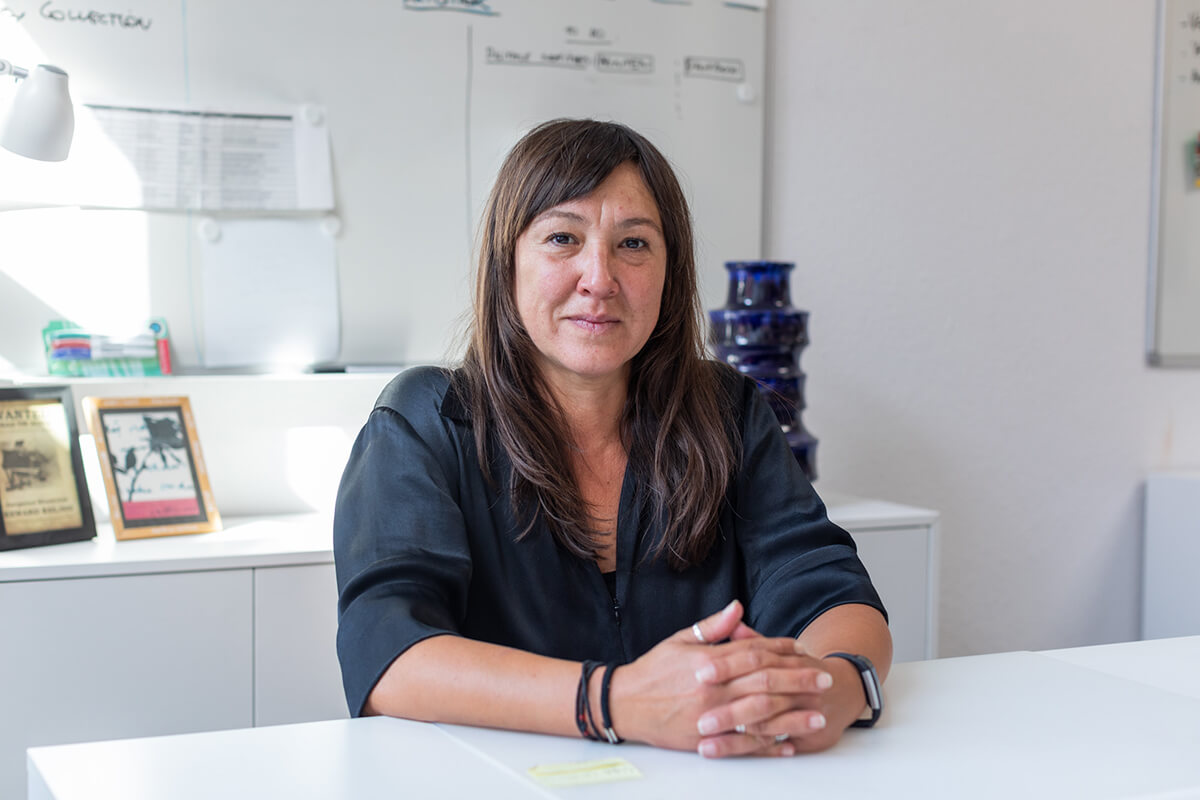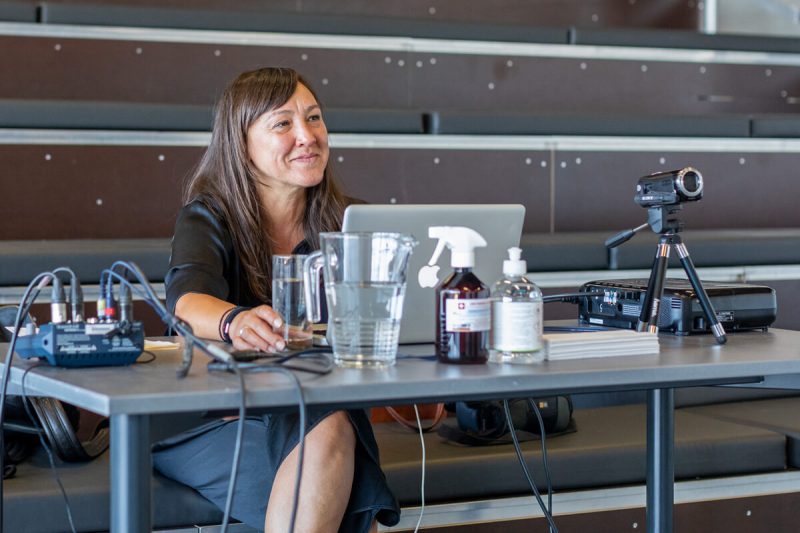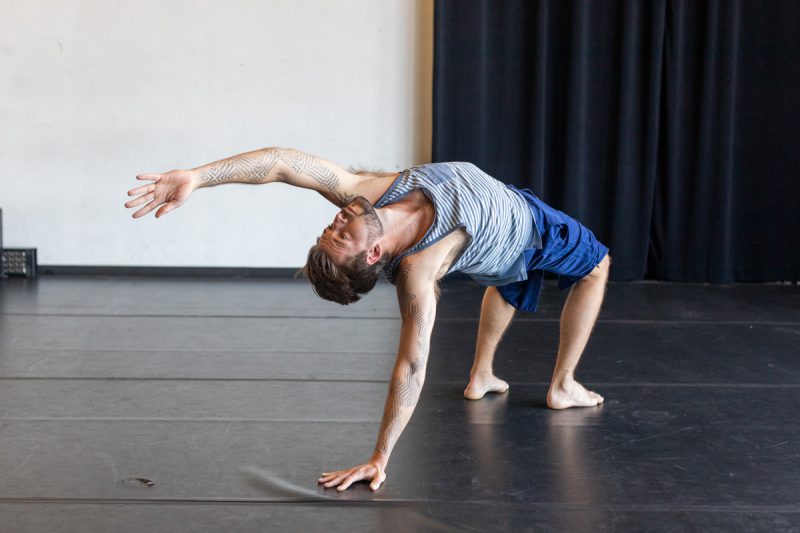Ann Van den Broek is a choreographer searching for new forms at the crossroads of dance, music, video and installation art. Driven by a strong personal need, she develops new forms of expression for human desires and social issues like depression and dementia. Ammodo spoke with Van den Broek about her triptych The Memory Loss Collection, physical memory, her future and passing on knowledge.

The main theme running through The Memory Loss Collection is memory loss. We often talk about this issue in terms of medical science or healthcare, but you approach it from a different perspective. How would you describe it?
My input is a choreographic perspective. To me that is a visual experience, it’s about positioning bodies in a space and adding rhythm – having those bodies express a mood or an emotion. I draw from existing sources as well as from my personal experience. Using people, cameras and sound I attempt to express something about memory loss from the perspective of caregivers, loved ones and patients. We don’t exactly know what memory loss is, especially in the last phase. We delve into the subject matter and also into that emotional state. It is an emotional and analytical expression of the disease and the memory loss associated with it. It is reflected in the body, in the movements and in the space. For instance, at some point we decided that the space was suddenly made up of many rooms and that you lose your way, and wonder whether or not you have already been here. The choreographic structure of the production is such that there is a lot of repetition in it, however with slight variations. I am seated at a table, but like the dancers I also occasionally wonder: what piece am in now? So it has an effect on me beyond the dance floor. That’s what being an artist is about, submerging yourself so deeply in the action that it takes over at times.
To what extent is this perspective obscured in our society’s daily life?
People caring for their loved ones often have difficulty talking about it. It is tough being confronted with having to help someone go to the bathroom. Not that we do that on stage, but it is about those kinds of things. About the process of deterioration. We don’t talk about that very much. Out of respect and that is good, but a lot of people are left with feelings and situations that they don’t know how to deal with. By talking about it more, we might come up with more solutions. There are also a lot people who have a parent or a partner that are affected by it, but they have busy lives and wonder how to deal with it. It is also about how our society in general deals with the disease. It affects a huge amount of people. In the early stages of dementia people still can and want to do many things. Feeling useful is so important and that’s one of the reasons I want to share this. I also want to morally support the people who are dealing with this. It’s always a little scary sharing with an audience. Apparently, some things are perceived as being confrontational.
I read in an interview with Marcelle Schots, who also wrote the book Protect/perform about your work: “Dance can give meaning in a way that is different from other art forms. It doesn’t need language. Great progress has come from a physical form of knowledge that was created intuitively.” I think that is a very interesting notion, that something can be discovered in dance that is later expressed in language.
That’s how I began my evolution as an artist. In the first ten years, I wanted to explore how much I could express with the body. Without sets, without cameras. The first time I used language I felt that there wasn’t more I could do with the body in a way I could believe in. It happened with the production I SOLO MENT. It was about mental isolation and psychoses. I didn’t want any theatrical choreographic nonsense, so I started looking for an element I could use to express a train of thoughts. I could do it through writing and drawings. But I needed a camera so the audience could see it. And that’s how I started adding more and more elements. They are totally different languages and I still have a problem with the technical puzzle. For me the body remains the essence. The other elements I use, in collaboration with the people I work with of course, are an extension of that – they are extra arms and legs. I can’t always express myself properly with words. Communication is problematic for me, while body language is often easier to understand. If I change the way I sit, it feels totally different. I do like language, like lyrics, some books and poetry. To me rhythm is very important. Rhythm is like a heartbeat. Time, space, rhythm. That’s life.
At that time you had a concrete reason and a necessity to work with language. Has your appreciation for it changed since then?
It has certainly evolved. In this production speech is used ‘normally’. Fragments of a scientific essay about the brain are spoken by an actress. I wanted to include that information. There are other ways of doing it, but I was inspired by a couple of impassioned professors I had spoken to while preparing for the piece. They have spent their whole life studying the matter.
Memory Loss is the closing piece of the triptych. The last few years it has been important to you to focus on transferring ideas, and language development. In that context you have organized workshops for your company.
Ideally I would do more of them, as recurring events throughout a season. But my organization cannot afford that yet.
What would be the dream scenario?
Our own space with a studio where study material is available, where I can give workshops and where people can make music. Where discussions can take place and information is exchanged. A place for physical and communication aspects.
Is that desire also related to…
… getting older? I want to share and pass things on.
… I was referring to passing on your vision of dance. I read somewhere that existing techniques do not offer you enough possibilities to express your view of humanity.
It sounds weird, but sometimes I tell dancers to forget everything they learned. For instance, even the way someone bends over. I often say: you look like a dancer – that’s beautiful, but now try being an average human being. Of course I want the performers and dancers I work with to have professional skills, otherwise they would not be able to count and perform all those combinations. But what I want to achieve is for them to be able to turn that on and off at will. The same applies to emotions. They must delve into them to feel aggression and desire, but also turn it off in a fraction of a second. You have to do that again and again in order to develop a physical memory. To see your body from the outside. Just like you learned a plié or a tendu, or learned how to walk. In my work method we keep repeating the emotions time and time again, switching back and forth and walking like average people do. By working on this it becomes like a cabinet with many drawers that you can open. You can perform a dance phrase in neutral state, then open the drawer of desire and perform that same dance phrase in that state. This changes the material.
Hearing you talk about it reminds me a bit of the exercises of Grotowski, the Polish theater innovator. Those exercises were quite intensive and they all lived in a community.
Yes, that’s fantastic. I followed a different path in life, but it must have been fabulous. That fanaticism goes so deep.
Is the younger generation in that sense still as fanatical?
I won’t risk saying anything about that. Everything changes, things are much faster now. I have the impression that people want constant change and don’t only work in one way. They want to get experience and try a lot of different things. That is not always easy for me.
You live and work in the Netherlands and in Belgium. How do you experience that?
My work is mostly supported by grants from the Netherlands. I live in Antwerp and my organization is located in Rotterdam. It is navigating between cultures, but also a coming together – both in dance and socially.
Are you still amazed by the differences or have you completely internalized that duality by now?
It’s quite normal for me to mix the Flemish and Dutch cultures. I moved to Rotterdam at the age of seventeen to attend the dance academy and I have been traveling back and forth ever since. And for eight years I lived in Amsterdam while I was working with Krisztina de Châtel. That duality is also in my work and if one of them would end, I would really miss it. I think this situation has been very important to my work and my personality. In a practical sense, because I was getting grants in the Netherlands. But also because of the reviews. There are Flemish and Dutch trends, such as theatrical dance and conceptual dance. If I were to operate in only one culture, I might have become too dependent on that. It helped me to develop my own style and to be a little bit stubborn. Also in terms of the structure of my organization. I am the general manager, while in the Netherlands it is customary to separate the business and the artistic management – and you are pressured to do that. I have a bit of both worlds. Saying what’s on my mind is more of a Dutch trait. The wait-and-see attitude, and seeing things from different perspectives, is more of a Flemish thing. I am not often amazed, but if I have to point out one thing it’s that things can be exceedingly organized in the Netherlands. Too many rules and regulation, even in the theater. For instance, the bars who are always closing so early. In Belgium, everywhere else actually, things are quite different. But the farther north you go…
Which artists do you follow or would you love to work with?
Nick Cave and the Bad Seeds I think are awesome. But I’m not sure if I could manage to create something with him. And there are a few filmmakers whose work I follow, such as Jim Jarmusch and David Lynch. Until recently I always had this drive to create things. Sometimes I’ll look for people to work with, but I always work with the same set designer, video and lighting designer. They have become mates, “vriendjes” as they say in the Netherlands, and perhaps that’s why I can’t or won’t work with anyone else. At first I was also afraid that I would be overshadowed at my own party. But now I think that it could be enriching to work on a concept with someone. It would depend on the type of collaboration. If a filmmaker came up to me and would let me do my own thing, it wouldn’t be a problem. I know what my own language is now. And if we can’t agree on one thing, I can always propose to try a different perspective.
What is your wish or hope for the future, in terms of your audience?
What I think is unfortunate is that in the Netherlands audiences are put in boxes. When you perform in other countries you see a mixed audience that didn’t come especially to see dance. I mean they were different ages, people who usually go to movies, or simply enjoy visiting a particular venue. In the Netherlands you have a regular dance audience and I would love to change that. You would have to do that in collaboration with theaters and other organizations. For instance by making a brochure without separate sections for dance, music, and theater. It wouldn’t change everything, but maybe shake things up a little. My piece Accusations, for example, was actually more of a choreographed concert. So was Zooming in on Loss. But they were advertised as dance pieces. We did not announce them that way. By doing so you create a certain image and expectation, and afterwards people might say that it wasn’t a dance piece. That is a missed opportunity.
How has corona affected your work?
We were supposed to tour and perform Memory Loss at Julidans. Both have now been cancelled. It is a large production that we cannot adapt. So we moved it to the 2020-2021 season, and we’ll go on tour with the entire triptych. We have made alternative plans for the fall by reprising two earlier works: Zooming in on Loss and Accusations. I am also working on a small creation called Creating Joy. It’s about enjoying the little things in life, in spite of setbacks. It was already planned before corona and it is very relevant now. We have gone from one extreme to the next. From doing a lot to sitting at home and organizing everything from distance. I hope that we will change how we deal with our fellow man and the environment in the future. It doesn’t seem to make sense anymore to travel to another country with the whole company for just one performance. That is terrible. We must continue to tour, but maybe we could stay in one place longer so it has more of an impact on audiences and the company itself. We have been discussing this internally and with our booking agent, but it all depends on how theaters and festivals will respond. Everything is going so fast and is more about quantity than depth. It’s madness. In that sense this has been good. I have always needed time to recuperate after the intensity of my pieces. To cook, read, let go of the previous period. I think I’m beginning a new period in terms of my work. I will always dig deep, what I create is always intense. But I am also getting older. I’m mellowing. I’m more grateful for everything there is. I feel happiness for everything that has happened over these past years and I want to share that with people as well.
Photography: Florian Braakman

